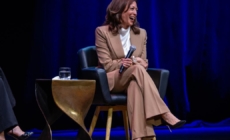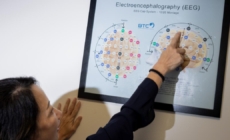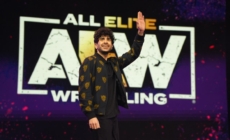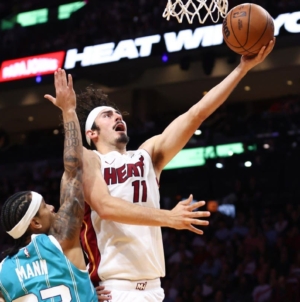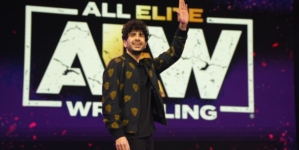-
Heat’s Jaime Jaquez Reveals Bold Stance on NBA Expansion to Mexico City - 9 mins ago
-
Massive leak exposes 183 million stolen email passwords from malware - 13 mins ago
-
Commentary: These are thirsty times. No wonder Kamala Harris’ book tour is a fan fest - 48 mins ago
-
Hulu Makes Final Decision on ‘King of the Hill’ Revival Season 2 - 48 mins ago
-
Will Vanderbilt keep their magical season going vs. Texas? 🤔👀 Joel Klatt Show - 54 mins ago
-
Researchers say there’s little evidence MERT treatment helps kids with autism - about 1 hour ago
-
New Favorite Emerges for Penn State Coaching Job After Matt Rhule News - 2 hours ago
-
Dodgers’ Offense Searching for Answers After a Rookie Put Them on the Ropes - 2 hours ago
-
Months after fire in Altadena, determination turns to despair - 2 hours ago
-
WWE Reportedly Interested in Top AEW Stars - 2 hours ago
Trump is feted by Asian allies he has shaken to the core
GYEONGJU, South Korea — There were declarations of a new “golden age” of alliances, photo stops in a gift store stocked with Trump memorabilia and even a golden crown.
On his three-country tour of Asia, President Donald Trump received a warm welcome from foreign leaders and showcased a diplomatic style rooted in personal rapport and dealmaking, culminating in the trade truce he reached Thursday with Chinese President Xi Jinping.
Trump appeared to relish his reception from leaders of Asian allies and partners who sought every possible opportunity to flatter and delight him even as their countries are reeling from the impact of his tariffs and other policies.
Putting his arms literally and figuratively around Japan’s newly elected Prime Minister Sanae Takaichi, Trump in Tokyo promised a “new golden age” of U.S.-Japan relations and accepted a gift of cherry blossom trees and a putter that belonged to his friend, the late former Japanese leader Shinzo Abe.
Takaichi was the second Asian leader on this trip to say she would nominate Trump for the Nobel Peace Prize he so highly covets, after Cambodian Prime Minister Hun Manet, whose ceasefire agreement with Thailand was brokered in part by Trump.
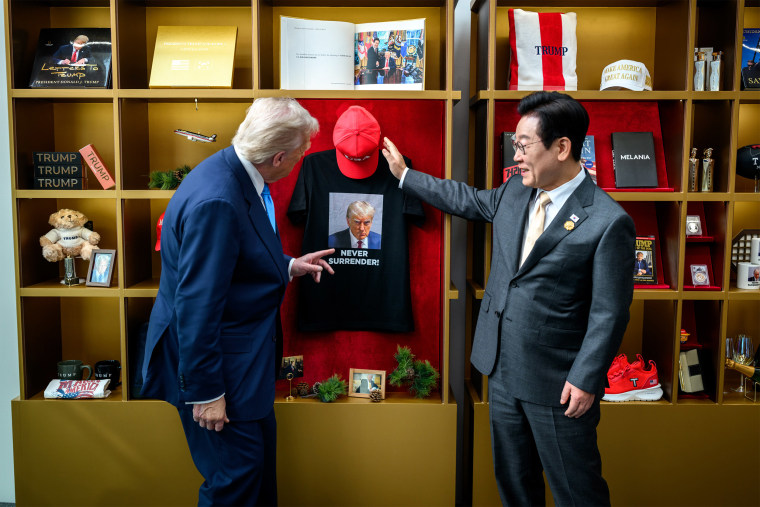
In Gyeongju, Trump received a large golden crown, a replica of the crown of the ancient Korean kingdom of Silla, from South Korean President Lee Jae Myung. Trump and Lee were pictured in a gift shop at the Gyeongju National Museum, where items on display included a red “USA” hat, Trump-branded sneakers and a shirt bearing the president’s mug shot.
A fighter jet escort and traditional dancers greeted Trump as he arrived Sunday in Malaysia, the first stop on his trip. After joining Trump in his motorcade, Prime Minister Anwar Ibrahim cracked a joke about a shared commonality, a reminder of some of the challenges faced by the American president before his election last November.
“I was in prison, but you almost got there,” Ibrahim quipped.
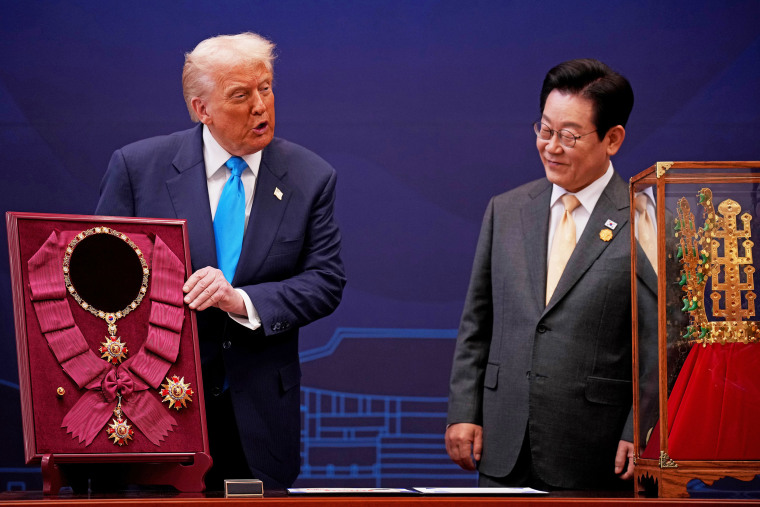
Even Xi, before sitting down with Trump in South Korea for their first meeting since Trump returned to office, told the president that China’s development “goes hand in hand with your vision to make America great again.”
Trump said the meeting with Xi, which lasted about an hour and 40 minutes, was “amazing,” rating it a “12” on a scale of zero to 10.
The warm embrace of Trump during the trip marked a contrast to the months of tense negotiations that preceded it. The administration had pushed ahead with a series of punishing tariffs as part of a broader effort to reset trade relationships.
Rates for key U.S. allies Japan and South Korea, now at 15%, are below those imposed on other countries but still high by historical standards, and have greatly strained ties.
“The agreement that was signed between the Japanese government and the American government on tariffs is so unbelievably one-sided,” said Jeff Kingston, a professor of Asian studies and history at Temple University’s Japan campus. “And the American side has sort of been trumpeting that fact.”
Earlier this year, a South Korean mayor flew to Washington to protest Trump’s tariffs outside the White House, saying 50% levies on steel in particular were pushing his steelmaking hub of Pohang to the brink of collapse.
Pohang is only about 30 minutes from Gyeongju, where Trump met with South Korean officials Wednesday to finalize a trade deal with the world’s 10th-largest economy. Trump said that a trade deal had been “pretty much finalized,” the details of which were later confirmed by a senior South Korean official.
The U.S.-South Korea trade deal comes less than two months after more than 300 South Korean workers were escorted in chains from a Hyundai plant in Georgia during a raid by U.S. immigration officials, a shocking sight that humiliated Koreans.
The image aired continuously on news programs in South Korea, which only weeks earlier had pledged $350 billion in U.S. investment. The workers later returned home without charges to cheers and protests, and a conciliatory message from Trump, who said he wanted foreign companies “to bring their people of expertise” into the country and didn’t want to “frighten off” investment.
Leaders this week signaled that they were ready to move past the friction. Takaichi signed framework agreements with the U.S. to secure a supply of rare earths and on nuclear power reactors, and even told Trump that she is considering a purchase of Ford F-150s for government work even though they are widely considered too big for Japanese streets. Trump responded by offering her “anything you want.”
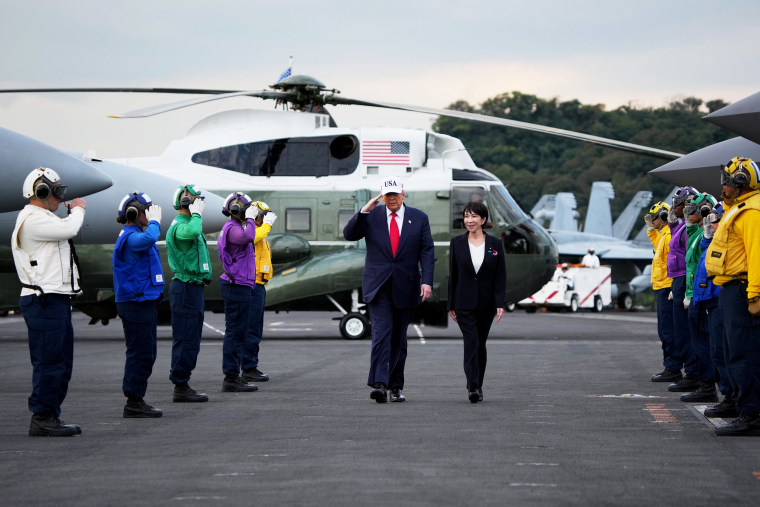
Addressing business executives in Gyeongju, Trump reflected on the differences between corporate dealmaking and heads-of-state diplomacy. He said he never believed in the idea of a win-win deal, but has since learned to search for balance.
“It really is a little bit different than you’re doing a business deal, and you want to just rip their hearts out,” Trump said. “But when you have nations, it’s a little bit different. You’ve got to all balance out a little bit.”
The president, who has long touted his negotiating acumen from the business world, spent the week emphasizing stronger partnerships and better balance in U.S. trade relationships.
He said after meeting with Xi that he was lowering fentanyl-related tariffs to 10% from 20% in exchange for greater efforts by China to stem the illicit international flow of precursor chemicals for the deadly opioid. The two leaders also reached an agreement to delay Chinese export curbs on strategically crucial rare earth materials.
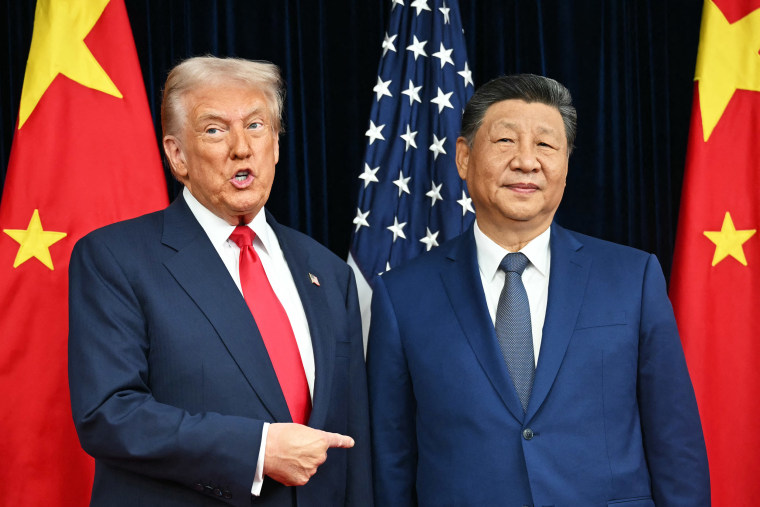
Trump “seems to have an affinity for President Xi, and I think that he seems to think of Xi not as an avatar of imperial ambition, but rather as the head of an impressive rival business company,” said Ali Wyne, an adviser on U.S.-China relations at the International Crisis Group.
Trump mused over how fast it had all come together.
“Can you believe it? One year ago, I was campaigning to win. Can you imagine that?” Trump said in South Korea this week. “Here I am president. We’ve done so many different things, economically, militarily, peace-wise. You know — peace through strength.”
Source link


